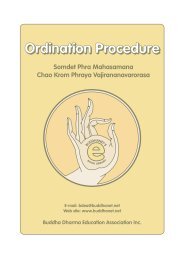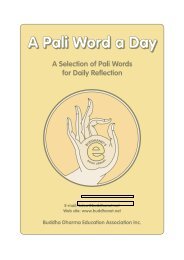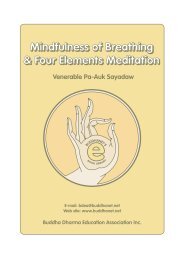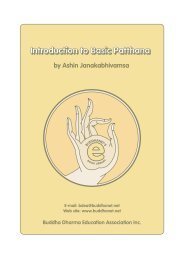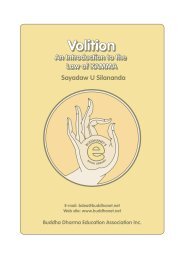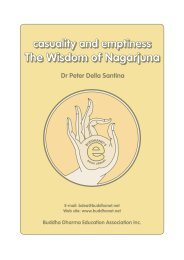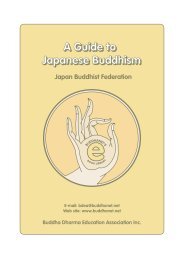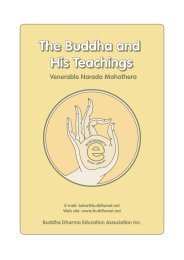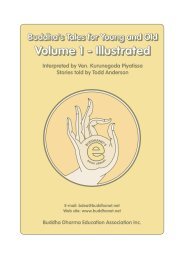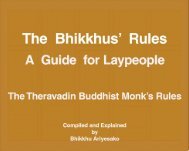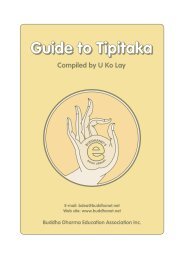No Inner Core: An Introduction to the Doctrine of Anatta - BuddhaNet
No Inner Core: An Introduction to the Doctrine of Anatta - BuddhaNet
No Inner Core: An Introduction to the Doctrine of Anatta - BuddhaNet
You also want an ePaper? Increase the reach of your titles
YUMPU automatically turns print PDFs into web optimized ePapers that Google loves.
more closely. Just as a scientist uses a microscope <strong>to</strong><br />
look at things in a labora<strong>to</strong>ry, so yogis must use concentration<br />
in Vipassanà meditation <strong>to</strong> penetrate in<strong>to</strong> <strong>the</strong><br />
unsubstantial, anattà nature <strong>of</strong> things. We must try <strong>to</strong><br />
see through <strong>the</strong> apparently solid mass <strong>of</strong> mental and<br />
physical phenomena.<br />
Regarding material things, we try <strong>to</strong> analyze and<br />
observe <strong>the</strong>m as earth, water, fire, air, and o<strong>the</strong>r material<br />
properties. Regarding mental phenomena, we try<br />
<strong>to</strong> see that, for example, one phenomenon is contact, ano<strong>the</strong>r<br />
feeling, and ano<strong>the</strong>r perception, although <strong>the</strong>se<br />
may have been experienced very rapidly as only one<br />
mental event. Both mental and physical phenomena<br />
are composed <strong>of</strong> only elements and forces, and thus<br />
have <strong>the</strong> nature <strong>of</strong> being anattà (unsubstantial). That<br />
is why we must try <strong>to</strong> observe everything very slowly<br />
in meditation in order <strong>to</strong> see that phenomena are not<br />
held <strong>to</strong>ge<strong>the</strong>r with a core, an atta.<br />
For example, all mental states and material properties<br />
have <strong>the</strong>ir own functions. Contact has one function,<br />
feeling ano<strong>the</strong>r, and perception still ano<strong>the</strong>r. If<br />
we see <strong>the</strong>se mental phenomena as one connected<br />
whole, we fail <strong>to</strong> see <strong>the</strong>m as parts with specific functions,<br />
and we fail <strong>to</strong> see <strong>the</strong>m as void <strong>of</strong> a central core,<br />
atta. These mental states actually have different ways<br />
<strong>of</strong> taking objects and responding <strong>to</strong> <strong>the</strong>m. Lobha (attachment)<br />
has one kind <strong>of</strong> response; dosa (hatred) ano<strong>the</strong>r.<br />
We must see <strong>the</strong> individual differences <strong>of</strong> <strong>the</strong>se<br />
mental states. We need <strong>to</strong> analyze and observe deeply<br />
<strong>to</strong> see that mind and matter have individual functions<br />
and responses. On superficial observation and analy-<br />
48



